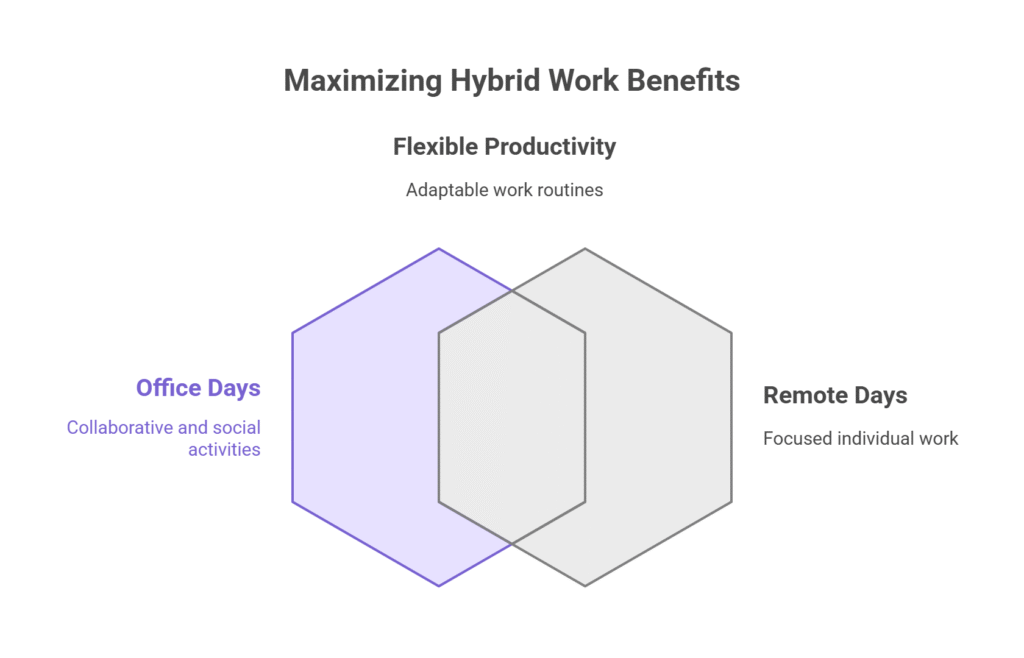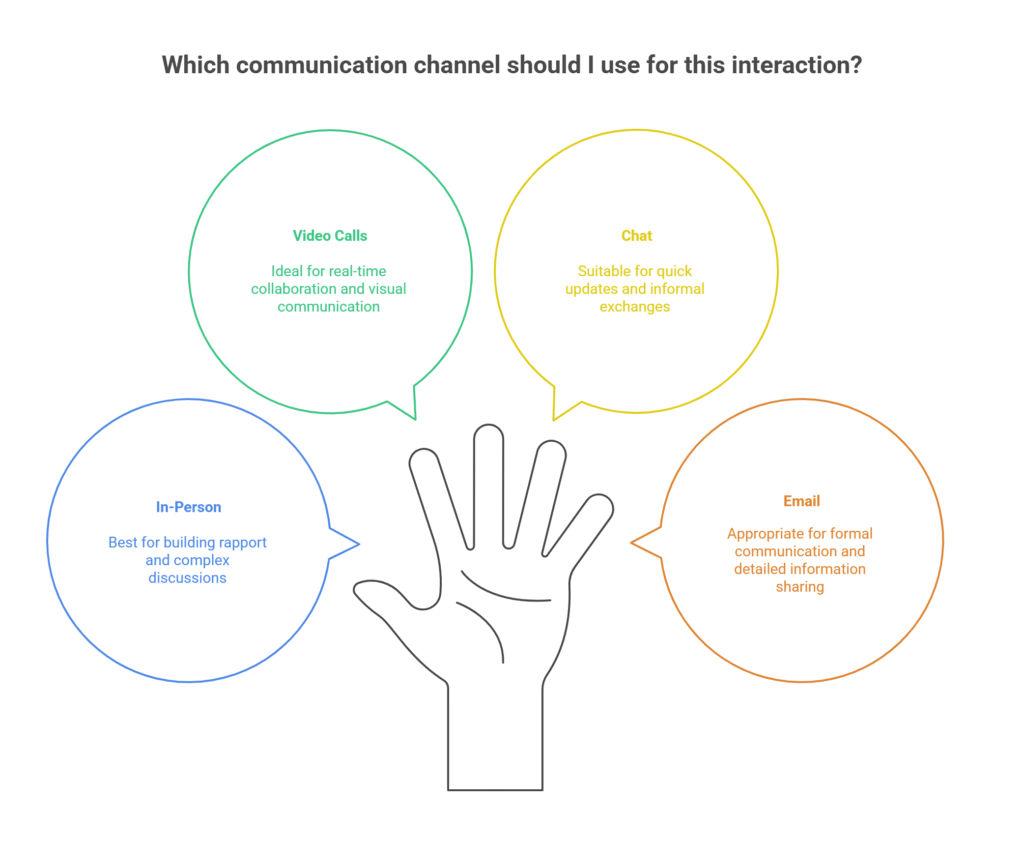Hybrid Work: Finding Your Sweet Spot Between Office and Home
Picture this: it’s Monday morning, and instead of rushing through traffic to get to the office, you’re sipping coffee at your kitchen table, already three tasks deep into your workday. Come Wednesday, you’re back at the office, brainstorming with colleagues around a conference table. This isn’t some futuristic fantasy – it’s the reality of the hybrid work model that’s reshaping how we think about work.
The hybrid work model isn’t just a trend that emerged from the pandemic. It’s become the new normal for millions of professionals who’ve discovered they can have their cake and eat it too. But finding the right balance between in-office collaboration and remote flexibility? That’s where things get interesting.
What Is a Hybrid Work Model Exactly?
A hybrid work model is pretty much what it sounds like – a blend of traditional office work and remote work that gives employees the flexibility to choose where they work based on their tasks, preferences, or company requirements. Think of it as the middle ground between the old-school “everyone in the office every day” approach and the fully remote setup.
But here’s the thing – not all hybrid models are created equal. Some companies let employees choose their own adventure, picking which days they want to be in the office. Others set specific days when everyone needs to be present. And some take a more fluid approach, where the nature of your work determines where you work.
The beauty of a hybrid workplace is that it acknowledges what we’ve all learned over the past few years: different tasks require different environments. Need to focus on that budget analysis? Home might be perfect. Planning a product launch with your team? The office conference room could be ideal.
What makes hybrid work different from just “working from home sometimes” is the intentionality behind it. Companies are designing policies, investing in technology, and rethinking their office spaces to make this model work for everyone.
The Rise of Flexible Work Arrangements
The pandemic basically forced a massive experiment in remote work, and the results were eye-opening. Companies that never thought they could function without everyone in the office suddenly realized their productivity didn’t collapse. In fact, many saw it improve.
But fully remote work isn’t perfect either. Some people missed the office chatter, the impromptu meetings, and the clear separation between work and home life. Others struggled with isolation or found it harder to collaborate on complex projects.
Enter the hybrid model – a response to the realization that one size doesn’t fit all when it comes to work arrangements. According to recent studies, about 60% of employees with remote-capable jobs actually prefer a hybrid arrangement over fully remote or fully in-office options.
Companies like Microsoft, Google, and Ford have all embraced different versions of hybrid work, each tailoring their approach to their specific needs and culture. The common thread? Flexibility is no longer a nice-to-have perk – it’s a business imperative.
Different Types of Hybrid Work Models
The hybrid work world isn’t a monolith. There are several flavors of hybrid arrangements, each with its own advantages and challenges.
Employee-choice hybrid gives workers the freedom to decide when they want to be in the office. This might mean choosing two days a week to work from home or deciding day-by-day based on their schedule. Companies like Airbnb have embraced this approach, trusting employees to make the best decisions for their productivity.
Fixed hybrid schedules are more structured. Everyone might work from home on Mondays and Fridays, with Tuesday through Thursday as office days. This predictability helps with planning and maintaining team cohesion, but it sacrifices some individual flexibility.
Office-first hybrid models expect employees to be in the office most of the time, with occasional remote work options. Think three to four days in the office, one to two days at home. This works well for companies that believe in-person collaboration is crucial but want to offer some flexibility.
Remote-first hybrid flips the script – employees work remotely most of the time but come into the office for specific purposes like team meetings, training, or social events. This approach maximizes flexibility while maintaining some face-to-face connection.
The right model depends on your company’s culture, the nature of your work, and your employees’ preferences. Many companies are still experimenting, adjusting their approach based on what they learn.
The Benefits That Make Hybrid Work Attractive
Let’s be honest – there’s a reason hybrid work has exploded in popularity. The benefits are pretty compelling for both employees and employers.
For employees, the improved work-life balance is huge. No more daily commute every day means more time for family, exercise, or just sleeping in. Parents can be home when kids get back from school. People with long commutes can reclaim hours of their day.
The flexibility to work in different environments based on the task at hand is another major plus. Need to focus on detailed work? Home might be perfect. Want to brainstorm with colleagues? The office energy could be just what you need.
From an employer perspective, hybrid work can be a powerful tool for attracting and retaining talent. Companies that offer flexibility have a competitive advantage in today’s job market. Plus, with fewer people in the office every day, many companies are reducing their real estate costs.
Research from Stanford shows that hybrid employees are just as productive as their fully office-based counterparts while being 33% less likely to quit. That’s a win-win if there ever was one.
The model also enables companies to tap into talent pools they might not have had access to before. When someone only needs to be in the office two or three days a week, they might be willing to accept a longer commute that would be unsustainable daily.
The Challenges You Need to Know About
Of course, hybrid work isn’t all sunshine and rainbows. There are real challenges that companies and employees need to navigate.
Communication can get tricky when some team members are in the office and others are dialing in from home. Those spontaneous hallway conversations that often lead to great ideas? They don’t happen as naturally in a hybrid world.
There’s also the risk of creating two classes of employees – those who are visible in the office and those who are working remotely. Remote workers might feel left out of important discussions or worry about being passed over for promotions.
Managing a hybrid team requires different skills than managing a traditional office team. Leaders need to be more intentional about communication, more thoughtful about meeting structures, and more proactive about ensuring everyone feels included.
Technology challenges are another consideration. Companies need to invest in tools that enable seamless collaboration between in-office and remote workers. That old conference room speakerphone isn’t going to cut it when half your team is joining virtually.
Some employees struggle with the constant switching between home and office environments. It can be harder to establish routines when your work location changes throughout the week.
Making Hybrid Work Schedules That Actually Work
The key to successful hybrid work isn’t just letting people work from home sometimes – it’s about being strategic about when and why people come into the office.
Many companies are discovering that certain activities work better in person. Complex problem-solving sessions, brainstorming meetings, and team building activities often benefit from face-to-face interaction. On the flip side, focused individual work, routine meetings, and administrative tasks can often be done just as effectively (or more effectively) from home.
Some organizations are experimenting with “anchor days” – specific days when everyone is expected to be in the office. This ensures that there are times when the whole team is together while still providing flexibility.
The timing of these anchor days matters too. Research suggests that Tuesday, Wednesday, and Thursday are the most popular office days, while Mondays and Fridays see lower attendance. Some companies are embracing this pattern, while others are trying to encourage more even distribution throughout the week.
Individual preferences matter too. Some people are naturally more productive in the morning, while others hit their stride later in the day. A good hybrid policy takes these individual differences into account while still maintaining some structure for team coordination.
Technology That Makes Hybrid Work Possible
The technology stack for hybrid work looks different from what most companies had pre-pandemic. Video conferencing tools like Zoom and Microsoft Teams are obviously crucial, but that’s just the beginning.
Collaboration platforms like Slack, Microsoft Teams, or Asana help keep everyone connected and informed, regardless of location. Cloud-based file sharing ensures that everyone has access to the same information, whether they’re at their desk or their kitchen table.
The office itself needs to be reimagined for hybrid work. Conference rooms need to be equipped for hybrid meetings, with cameras that can capture everyone in the room and audio systems that make remote participants feel included. Many companies are investing in “smart” office technology that can automatically adjust lighting, temperature, and even book meeting rooms based on who’s in the building.
Some organizations are using workplace analytics tools to understand how their space is being used and make data-driven decisions about their hybrid policies. These tools can track occupancy rates, meeting room utilization, and employee preferences to help optimize the hybrid experience.
Personal technology matters too. Companies are providing stipends for home office equipment, ensuring that employees have the tools they need to be productive regardless of where they’re working.

The Psychology Behind Hybrid Work Success
Making hybrid work successful isn’t just about logistics – it’s about understanding the psychological factors that influence how people work best.
The concept of “presence bias” is real. There’s a tendency to assume that people who are physically present are working harder or are more committed. Hybrid work requires managers to shift their focus from presence to outcomes.
Social connection is another crucial factor. Humans are social creatures, and the informal interactions that happen naturally in an office setting serve important psychological functions. Successful hybrid companies are intentional about creating opportunities for social connection, whether through virtual coffee chats, team lunches, or office social events.
The autonomy that comes with hybrid work can be incredibly motivating for many people. When employees feel trusted to make decisions about where and when they work, it often leads to increased job satisfaction and productivity.
But autonomy can also be overwhelming for some people. Not everyone thrives with complete flexibility. Some employees prefer more structure and clearer boundaries between work and personal time.
Industry-Specific Considerations
Not every industry is equally suited to hybrid work. Professional services, technology, and finance have generally found it easier to implement hybrid models than manufacturing, healthcare, or retail.
But even within compatible industries, different roles have different hybrid potential. A software developer might thrive in a fully flexible arrangement, while a customer service representative might need more structured hours to ensure coverage.
Some companies are taking a role-based approach to hybrid work, with different policies for different positions. Sales teams might have maximum flexibility, while operations teams might need more coordination and structure.
The nature of client relationships also matters. Companies that rely heavily on in-person client interactions might need more office presence than those that work primarily with remote clients.
Creating a Hybrid Work Culture
Company culture doesn’t automatically translate to a hybrid environment. It requires intentional effort to maintain and evolve.
Communication needs to be more explicit in a hybrid world. The assumptions and informal knowledge sharing that happen naturally in an office don’t translate automatically to a distributed team.
Recognition and celebration need to be reimagined too. The traditional office birthday cake or impromptu celebration of a big win doesn’t work when half the team is remote. Successful hybrid companies are creative about finding ways to acknowledge achievements and build team camaraderie.
Onboarding new employees is particularly challenging in a hybrid environment. New hires need to learn not just their job, but also how to navigate the hybrid culture and build relationships with colleagues they might only see occasionally.
Measuring Success in Hybrid Work
How do you know if your hybrid work model is actually working? The metrics matter, but they’re different from traditional office productivity measures.
Employee satisfaction surveys are crucial. Are people happy with their hybrid arrangement? Do they feel connected to their team and the company? Do they have the tools and support they need to be productive?
Productivity metrics need to focus on outcomes rather than hours worked or time spent in the office. What gets delivered? How quickly? At what quality level?
Retention rates tell an important story too. Are you keeping your best people? Are you attracting top talent? The ability to offer flexible work arrangements is increasingly important in competitive job markets.
Collaboration effectiveness is another key measure. Are teams working well together? Are projects moving forward smoothly? Are there communication breakdowns or delays?

The Future of Hybrid Work
Hybrid work isn’t a temporary pandemic response – it’s becoming a permanent feature of the modern workplace. But it’s still evolving.
We’re likely to see more sophisticated approaches to hybrid work, with AI helping to optimize schedules and space utilization. Companies are experimenting with different models, learning what works and what doesn’t.
The technology will continue to improve, making remote collaboration more seamless and natural. Virtual reality and augmented reality might eventually make remote participation in meetings feel more like being there in person.
Office design is changing too. The traditional cubicle farm is giving way to more flexible, collaborative spaces designed to support hybrid teams.
Quick Takeaways
- Hybrid work models combine office and remote work, offering flexibility while maintaining team connection
- Different models work for different companies – from employee-choice to fixed schedules to office-first approaches
- Benefits include improved work-life balance, reduced commuting, and access to broader talent pools
- Key challenges involve communication, collaboration, and preventing two-tiered employee experiences
- Success requires intentional planning, investment in technology, and focus on outcomes rather than presence
- The future of work is flexible – companies that adapt will have competitive advantages in talent acquisition and retention
Finding Your Hybrid Sweet Spot
The hybrid work model isn’t going anywhere. It’s become a permanent fixture in the modern workplace because it addresses real needs – for flexibility, for connection, for productivity, and for work-life balance.
But here’s the thing: there’s no universal “right” way to do hybrid work. What works for a tech startup might be completely wrong for a law firm. What works for one team might not work for another team in the same company.
The key is to approach hybrid work thoughtfully. Start with your goals – what do you want to achieve? Then design policies and practices that support those goals. Be willing to experiment and adjust based on what you learn.
Remember that hybrid work is about more than just where people work. It’s about creating a culture of trust, focusing on outcomes, and supporting your people in doing their best work – wherever that happens to be.
The companies that thrive in this new world will be those that embrace flexibility while maintaining the human connections that make work meaningful. It’s not about choosing between office and remote – it’s about finding the right blend for your unique situation.
Frequently Asked Questions
Q: How many days should employees work from home in a hybrid model? Most successful hybrid models involve 2-3 days in the office and 2-3 days remote. The sweet spot seems to be around 60% office, 40% remote, but it really depends on your team’s needs and the nature of your work.
Q: What’s the difference between hybrid and flexible work? Hybrid work specifically refers to splitting time between office and remote locations. Flexible work is broader and might include flexible hours, compressed workweeks, or job sharing without necessarily involving remote work.
Q: How do you prevent remote workers from being left out? Successful hybrid companies are intentional about inclusion. This means making sure remote participants can fully participate in meetings, sharing information transparently, and being mindful of informal conversations that happen in the office.
Q: What jobs work best with hybrid models? Knowledge work that can be done independently often works well with hybrid arrangements. This includes roles in technology, finance, marketing, and professional services. Jobs requiring physical presence or real-time coordination may be less suitable.
Q: How do you manage productivity in a hybrid workplace? Focus on outcomes rather than hours worked. Set clear expectations, establish regular check-ins, and use project management tools to track progress. Trust your employees and measure results, not presence.
Q: What technology is essential for hybrid work? Video conferencing tools, cloud-based file sharing, collaboration platforms, and project management software are the basics. Many companies also invest in upgraded office technology to support hybrid meetings.
Q: How do you maintain company culture with hybrid work? Be intentional about creating connections. This might include virtual social events, team lunches when everyone’s in the office, clear communication about company values, and regular one-on-one check-ins with team members.



